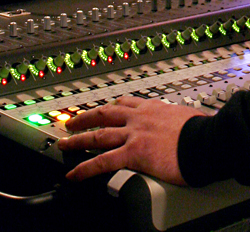
Suitably Equipped
Source-oriented reinforcement has been used successfully by a growing number of theatre sound designers, event producers and even DJs over the past 15 years or so, and this is where a large matrix comes into its own. Happily, many of today’s live sound boards are suitably equipped, with delay and EQ on the matrix outputs.
The situation becomes more complex when there is more than one talker, a wandering preacher, or a stage full of actors, but fortunately, such cases can be readily addressed as long as correct delays are established from each source zone to each and every loudspeaker on a one-to-one basis.
This requires more than a console level matrix with just output delays, or even assigning variable input delays to individual mics, since it necessitates a true delay-matrix allowing multiple independent time-alignments between each individual source zone and the distributed loudspeaker system.
One such delay matrix that I have used successfully is the TiMax2 Soundhub, which offers control of both level and delay at each crosspoint in matrixes ranging from 16 x 16 up to 64 x 64 to define unique image definitions anywhere on the stage or field of play.
The Soundhub is easily added to a house system via analog, AES digital, and any of the various audio networks currently available, with the matrix typically being fed by input-channel direct outputs, or by a combination of console sends and/or output groups, as is the practice of the Royal Shakespeare Company, among others.
A familiar looking software interface allows for easy programming as well as real-time level control and 8-band parametric EQ on the outputs. A PanSpace graphical object-based pan programming screen allows the operator to drag input icons around a set of image definitions superimposed onto a jpg of the stage, a novel and intuitive way of localizing performers or manually panning sound effects.
For complex productions involving up to 24 performers, designers can add the TiMax Tracker, a radar-based performer-tracking system that interpolates softly between image definitions as performers move around the stage, thus affording a degree of automation that is otherwise unattainable.
Where very high sound pressure levels are not required, reinforcement of live events may best be achieved not by mixing voices and other sounds together, but by distributing them throughout the house with the location cues that maintain their separateness, which is, after all, a fundamental contributor to intelligibility, as anyone familiar with the “cocktail party” effect will attest. As veteran West End sound designer Gareth Fry says, “I’m quite sure that in the coming years, source-oriented reinforcement will be the most common way to do vocal reinforcement in drama.”
While mixing a large number of individual audio signals together into a few channels may be a very real requirement for radio, television, cinema, and other channel-restricted media such as consumer audio playback systems, this is certainly not the case for corporate events, houses of worship, theatre and similar staged entertainment.
It may sound like heresy, but just because it’s sound doesn’t mean it has to be mixed. We now have more than the proverbial hammer at our disposal. With the proliferation of matrix consoles, adequate DSP, and sound design devices such as the TiMax2 Soundhub, mixing is no longer the only way to work with live sound – let alone the best way for every occasion.
Sound designer Alan Hardiman is president of Associated Buzz Creative, providing design services and technology for exhibits, events, and installations.

